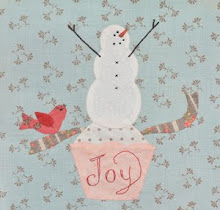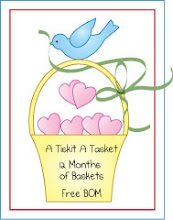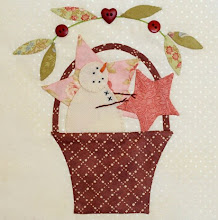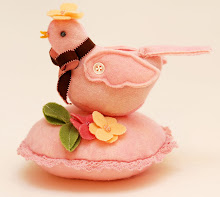“Rabbits Prefer Embroidery” is back from the quilter! Now its binding time, and then off to the photographer. Before too long we will have a new pattern available!
If you’re new to embroidery, I’ll share a few tips with you over the next few posts. I hope to get you started on the road to embroidery heaven. Yes, there is such a place… you’ll find it in front of the TV every evening. Just sit down, relax, and embroider away on your favorite project.
Supplies & Basics:
- Embroidery floss or pearl cotton; there are so many wonderful choices on the market! Pick and choose from some or all! DMC, Valdani, Weeks Dye Works, and Lecien just to name a few.
- Small sharp scissors
- Embroidery needles of assorted sizes
- Embroidery hoop: size 5 is all purpose
- Backing
- Pigma pen, water erasable marker or fabric pencil
Embroidery Floss:
Hold the skein of floss in one hand and shake the floss to release the cut end. Pull this end of the floss and cut off about 18 to 20”of floss .
Now separate the strands of floss, one thread at a time. Grab one strand of floss and pull it up, straightening the remaining floss as you pull. Repeat for the number of threads you need. Do not try to pull off two or three threads at one time. Oh what a mess you’ll have!
Embroidery Needles:
Embroidery needles have a larger eye than regular sewing needles. The smaller the number the larger the eye (and the longer the needle).
I prefer a short needle for stitching and use a size 10 for most of my work. The short needle gives me more control and makes it easier to sew tiny stitches. If I’m using a pearl cotton or more than two strands of floss I’ll switch to a size 6, 7, or 8 embroidery needle.
Markers: What’s up with all these?
Pigma Permanent Pen, size 01, makes a fine line that is easy to cover with stitching. It’s the pen most embroidery patterns call for. But keep in mind that the pen mark is permanent. If you make a mistake, or go out of the line, you can’t go back and change it.
Clover water erasable pen; Such a bad rap this marker has, but I use it to mark a lot of my embroidery. The secret to using this pen? Use only the Clover eraser pen to remove the marks and not water.
Fabric pencil; fabric pencils glide easily over the fabric and do not “grab” the fabric like a regular pencil. Most fabric pencils can be erased with a fabric pencil eraser. I suggest not trying to use water to erase the marks, as most products claim you can. I found the results disappointing.
Backing Stabilizer:
Backing hides the thread tails and gives the embroidery more stability. It is not a necessity, but most embroidery patterns call for it. I choose from two types depending on the look I want;
Lightweight fusible interfacing; Gives the embroidery fabric more stability and makes it easier to get an even tension. Cut the interfacing the same size as the background fabric. Trace design onto the background fabric and then iron the interfacing to wrong side of the background.
Lightweight flannel; gives the embroidery a slightly softer look. It’s the backing I used for “Rabbits Prefer Embroidery”. Treat the backing and embroidery fabric as one when you are piecing together your quilt as shown in the photo below.
Hoop:
To hoop or not to hoop! No groaning allowed. Remember, hoops have been around for YEARS and do have a purpose! Hoops keep the fabric taunt and make it easier to control the tension. The thinner the background fabric the more necessary the hoop becomes. A simple 5” plastic hoop will probably be all you need.
When I use a flannel backing I only use a hoop when I come to an area where I need a lot of control.
Are you ready to do some stitching? I’ll be back with a few tips on that too!
Hugs,











